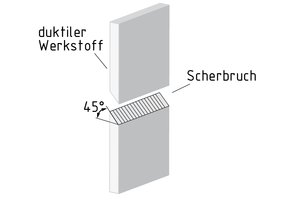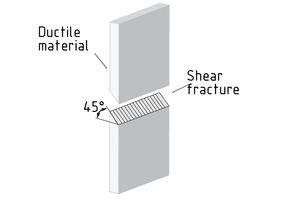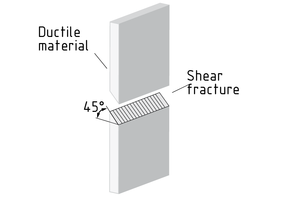
Wählen Sie eine
oder mehrere Sprachen aus
0,1,0
- Deutsch
- Englisch
- Chinesisch
- Spanisch
Schubspannungshypothese

Die Schubspannungshypothese ist eine Festigkeitshypothese, bei der die Differenz der auftretenden Hauptnormalspannungen $({{\sigma }_{1}}-{{\sigma }_{2}})$ durch eine Vergleichsspannung ${{\sigma }_{v}}$ ersetzt wird. Die Schubspannungshypothese dient der Bestimmung der maximalen Tragfähigkeit eines mehrachsig belasteten Bauteiles.
Die Hypothese ist bei Werkstoffen oder Bauteilen mit duktilen Eigenschaften anwendbar. Es wird von dem Fließen, also der plastischen Verformung eines Bauteils, ausgegangen. Somit ist die größte wirkende Schubspannung für das Versagen eines Bauteils verantwortlich.
Die Bruchform eines duktilen Werkstoffes erfolgt als Scherbruch, der im idealen Fall unter 45° verläuft.
Maximum shear stress theory

The maximum Shear stress theory is a failure theory according to which the difference between the principal normal stresses occurring $({{\sigma }_{1}}-{{\sigma }_{2}})$ is replaced by an equivalent stress ${{\sigma }_{v}}$. The maximum shear stress theory is used to determine the maximum load-Bearing capacity of a component subjected to multiaxial stresses.
The theory can be used for materials or components with ductile properties. The starting point is a component's (plastic) flow, i.e. its plastic deformation. The greatest shear stress acting on a component is thus responsible for its failure.
When a ductile Material ruptures, this takes the form of a shear fracture - ideally, at less than 45°.
最大剪应力理论

最大剪应力理论描述了材料失效与最大剪应力的关系,其中作用于材料的法向主应力 ( ${{\sigma }_{1}}-{{\sigma }_{2}}$ ) 由相当应力 ${{\sigma }_{v}}$ 替代。最大剪应力理论用于确定多轴应力状态下的材料的强度极限。
这一理论适用于韧性材料。起点即为材料的屈服点,即其塑性形变起点。作用于材料的最大剪应力是引起材料屈服失效的主要因素。
韧性材料的理想剪切断裂角小于 45°。
剪切断裂
Teoría del esfuerzo de corte máximo

La teoría del esfuerzo de corte máximo es una teoría de falla de acuerdo con la cual la diferencia entre los esfuerzos normales principales que se producen $({{\sigma }_{1}}-{{\sigma }_{2}})$ es reemplazada por un esfuerzo equivalente ${{\sigma }_{v}}$ . La teoría del esfuerzo de corte máximo es usada para determinar la capacidad de carga máxima de un componente sujeto a esfuerzos multiaxiales.
La teoría puede ser usada para materiales o componentes con propiedades dúctiles. El punto de inicio es el flujo (plástico) de un componente, es decir, su deformación plástica. El mayor esfuerzo de corte que actúa en un componente es, por lo tanto, el responsable de su falla.
Cuando un material dúctil se rompe, este toma la forma de una fractura por corte, idealmente a menos de 45°.
Fractura por corte
